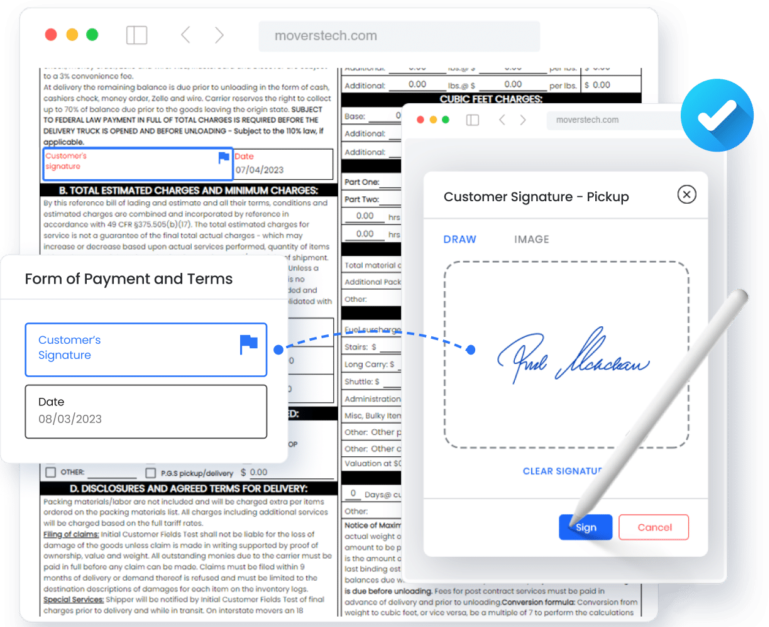Document automation is a massive administration upgrade for those in the moving industry. By following document automation best practices, your moving company can greatly improve its efficiency. Processing essential documents easily, from quotes to invoices, reduces errors and saves time, allowing you and your crew to focus on delivering exceptional service. In addition, document automation brings better organization, gives easier access to information, and aligns perfectly with modern moving software solutions. Integrating document automation will help your moving company work more efficiently, streamline how your team handles tasks, and improve customer service.
The benefits of going paperless
Digital document management is only one of many CRM benefits for local movers. It provides a complete view of customer interactions, making it easier to track and manage client relationships. Aside from document management, a CRM is especially useful during hectic moving days or when dealing with last-minute changes. Movers can update client information on the go, ensuring smooth communication and increased customer satisfaction. Switching to a paperless system optimizes operational efficiency and significantly improves service quality, which aligns perfectly with the goals of modern moving businesses.
The shift towards a paperless system offers multiple benefits, which significantly help those in the moving industry. Your moving company can achieve peak efficiency with the help of digital document management. This method eliminates heaps of physical paperwork, simplifying operations significantly. Instant access to documents like contracts and inventory lists ensures quick responses to client queries. Besides, going paperless is a step forward in environmental responsibility, reducing paper waste and carbon footprint.

Integrating online bookings, eSignatures, and digital payment processing further enhances the capabilities of CRM systems for moving companies. Online booking systems streamline the process of scheduling moves, allowing customers to book services at their convenience. This not only saves time but also reduces the need for phone calls and manual scheduling. eSignatures facilitate the quick and secure signing of documents such as contracts and agreements, speeding up the approval process and ensuring legal compliance. Additionally, incorporating digital payment methods offers customers a variety of secure and easy payment options. These CRM features make the moving process smoother for everyone and help moving companies work more efficiently.
Creating and E-signing documents
With automation, you can easily manage moving company documents. This technology allows for quick creation of important documents, such as Bills of Lading, directly from any device. It offers flexibility, as you can generate, send, and receive signed documents without the need for physical paperwork. E-signing enhances efficiency, enabling you to handle documentation even when on the move. This capability is especially crucial during busy periods or when dealing with urgent client requests. It ensures that all necessary paperwork is completed promptly and accurately, allowing for smoother operations. A digital method like this saves time and improves the overall customer experience, which shows a mover’s commitment to modern and efficient practices.
Reducing risks of handling physical paperwork
Digitalizing documents reduces the risks involved in handling physical documents. In the moving industry, the loss or damage of important paperwork like contracts and inventory lists can lead to operational difficulties and client dissatisfaction. The transition to digital documents eliminates these risks. Digital files are secure and easily retrievable, ensuring critical information is always at hand. This change also protects against accidental damage, which can be a common issue with paper documents, especially in the unpredictable environment of moving. For movers, switching to digital documentation is a strategic move towards reliability and professionalism, ensuring easy operations even on the busiest of days.
Cost savings
With digitization, moving companies can save a lot of money. By reducing the need for printing, you reduce money spent on ink, paper, and printing equipment maintenance. Digitalization also means no more paying for physical storage of documents, freeing up space and reducing costs. Handling digital documents is even more efficient, saving time and labor costs associated with manual sorting and filing. Integrating digital practices with efforts to automate moving company finances further simplifies operations. This addition allows more accurate financial tracking and budgeting, which ensures a more economical and efficient approach to managing business finances, especially during peak moving periods.
Improving customer experience
Digital paperwork access can greatly enhance customer experience during the move. Providing clients with instant access to digital documents like quotes, contracts, and inventory lists shows transparency and builds trust. It allows customers to review and approve documents conveniently, offering flexibility and control over the moving process. This accessibility is especially beneficial during stressful moving periods, as it ensures clear communication and reduces uncertainty. Offering digital access to documents signifies a commitment to customer satisfaction and modern service standards. It makes interactions effortless, speeds up approval processes, and ultimately leads to happier customers, which is crucial for building a strong, reputable moving business.

User-friendly interfaces
The importance of user-friendly interfaces in document creation and management cannot be overstated, even more so in the moving industry. An intuitive interface simplifies the process of generating, accessing, and updating documents, making it accessible to everyone, regardless of how well they can use technology. This ease of use is crucial during busy moving periods when time is a crucial factor. Quick and straightforward access to documents like client contracts or inventory lists ensures efficiency and helps avoid delays. An intuitive system also reduces the learning curve for new staff, which means they will become productive faster.
Aside from that, it minimizes the chances of errors that can occur with more complex systems. For movers, a user-friendly interface in their document management systems means they can focus more on delivering quality service to their clients and less on navigating complicated software. This way of doing business increases operational efficiency and contributes positively to overall customer satisfaction.
Best practices for data security
In the moving industry, it’s important to prioritize the security of digital documents and customer information. Moving companies should follow good practices in data security and document automation to keep data safe. This includes using secure storage, setting up strong access controls, keeping software up-to-date, educating staff about data security, and backing up information regularly.

Automate your documents and move forward
The evolution of document automation is shaping the future for movers. Because of that, utilizing best practices in document automation for movers is a strategic necessity. It leads to enhanced efficiency, improved customer satisfaction, and strong data security. Looking ahead, this technology will become even more impactful, as it will further simplify operations and grow the business. Movers should consider investing in these innovations to stay competitive and match the modernizing aspect of the industry. Now is the time to use these practices and reap their benefits. Start today towards a more efficient, customer-centric, and secure future in the moving business.

